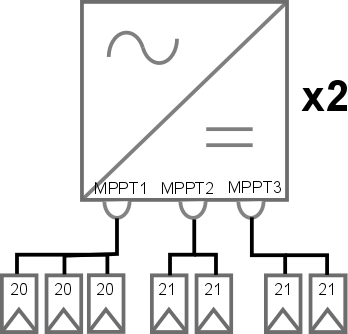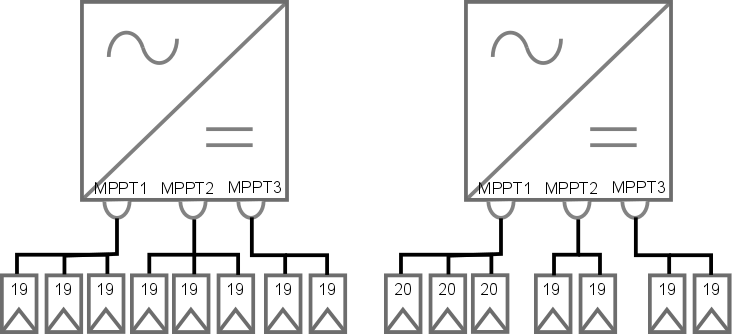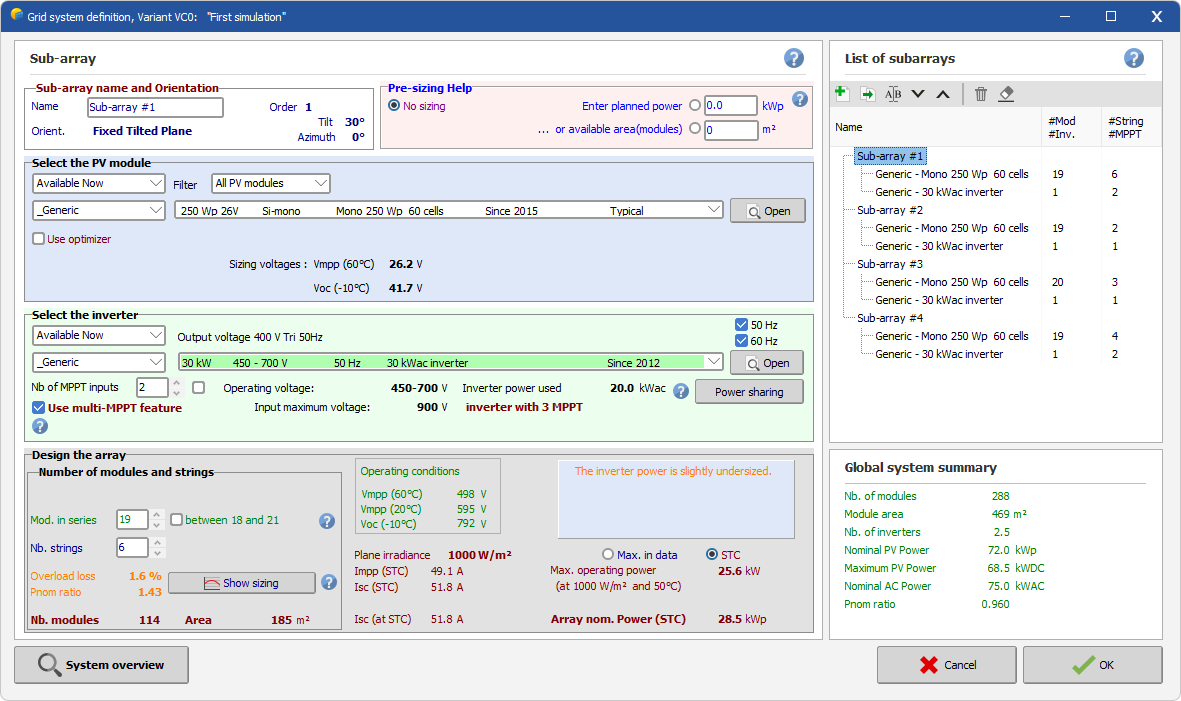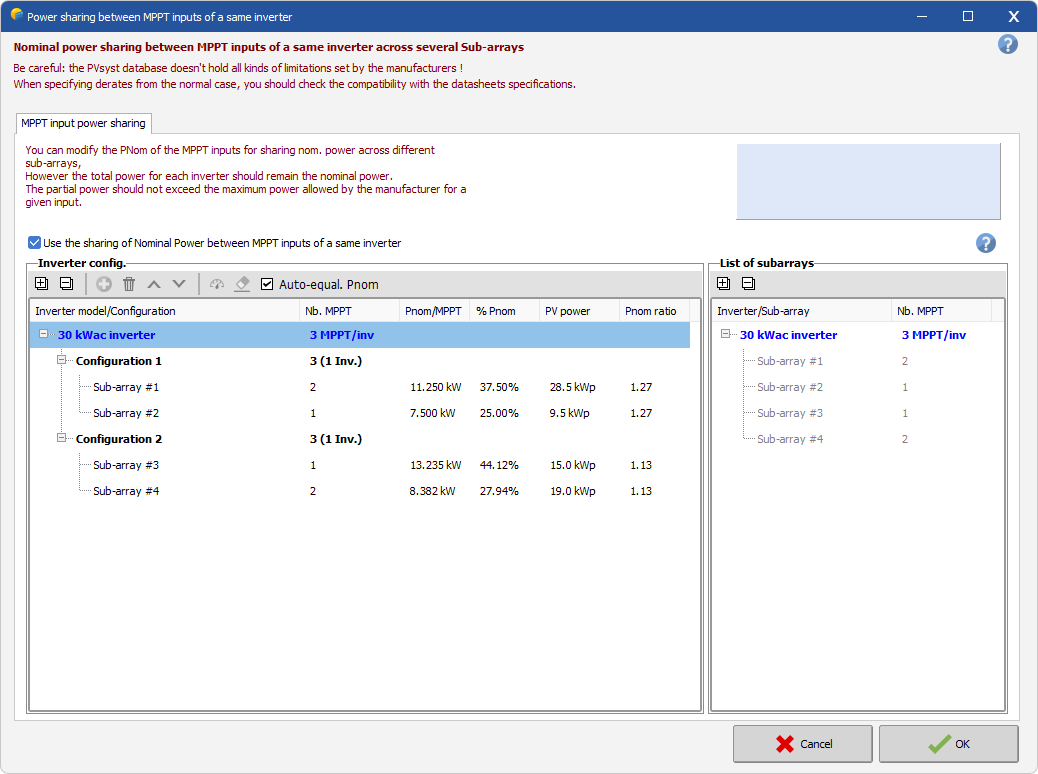Multi-MPPT : more examples
Default behavior
If the inverters have a single input, PVsyst will search for the most balanced situation. If the inverters have multiple inputs, PVsyst will distribute in the most balanced way across inputs.
Example 1
340 strings on 6 inverters with a single input, lead to:
- 2 inverters with 56 strings
- 4 inverters with 57 strings.
Example 2
If the inverters in the above example would have 3 inputs each, this leads to:
- 2 Inverters with 18 strings on one input and 19 strings on two other inputs
- 4 inverters with 19 strings on each input.
Overall, 2 inputs with 18 strings and 16 inputs with 19 strings.
Multi-MPPT feature
When you use ‘multi-MPPT feature’, the dialogue will show the MPPT inputs, not the whole inverters. This allows to configure inputs of the same inverter differently, by creating several sub-arrays. The advantage of using ‘multi-MPPT feature’ is that the nominal power of each input need not be the same. By default, PVsyst will distribute the total nominal power of the inverter equally among the individual MPPT inputs. This means that inputs with more DC power are closer to the power limit, and thus to clipping, than the ones with smaller DC power. This is especially important for string inverters, where the number of strings per input is rather small. This can lead to large DC unbalance between the MPPT inputs.
Example 3
The equivalent configuration of the above example would be:
- 1 sub-array with 2 MPPT inputs and 36 strings
- 1 sub-array with 16 MPPT inputs and 304 strings.
Power sharing
If the inverter has the capability to shift part of the nominal power between the inputs, this can be configured in the ‘Power Sharing’ window. In this way, all inputs will reach the power limit at the same external weather conditions.
Example 4
We take a PV installation using 288 Modules and 2 inverters with 3 inputs each. The strings should be 20 or 21 modules long. On one MPPT input, strings should have the same number of modules.
We therefore end up with 8 strings of 21 modules and 6 strings of 20 modules. These have to be distributed among the 2x3 MPPT inputs. This means that there are two inputs with 3 strings each and 4 inputs with 2 strings each. To get a balanced configuration, one of the inputs in each inverter will have 3 strings, and the other two 2 strings. The inputs with 3 strings cover the strings of 20 modules.
This means, that one of the inputs in each inverter will have 60 PV modules, and the other two will have only 42 modules each. To get a balanced situation, the Power sharing needs to be adjusted for equal nominal power. This means:
- 42% of the nominal power for the inputs with 3 strings, and
- 29% of the nominal power for each of the inputs with 2 strings.
Grouping the power sharing
To allow the matching of sub-arrays that contain MPPT inputs of the same inverter, it is possible to assign each sub-array to a power sharing group. These groups represent inverters with the same string and power sharing configurations.
Example 5
As an example, let us take the same number of modules as before (288), but limit the string length to a maximum of 20 PV modules. In this case, 15 strings would be needed:
12 strings with 19 modules each, and 3 strings with 20 modules each.
The 15 strings have to be shared by two inverters, meaning that one inverter takes 8 strings and the other one 7. To balance the system, we put the 3 longer strings on the inverter with 7 strings. This leads to the following configuration:
Inverter 1:
2 inputs with 3 strings of 19 modules (sub-array #1)
1 input with 2 strings of 19 modules (sub-array #2)
(152 / 288 modules = 53% of DC power)
Inverter 2:
1 input with 3 strings of 20 modules (sub-array #3)
2 inputs wit 2 strings of 19 modules (sub-array #4)
(136 / 288 modules = 47% of DC power)
To configure this level of detail, we need to create 4 corresponding sub-arrays. For example for sub-array #1:
In the power sharing, we associate sub-arrays for the same inverter.
Group 1: sub-array #1 and #2
Group 2: sub-arrays #3 and #4
Finally, we balance the nominal power between the inputs ('All Pnom Ratios identical'):
Sub-array #1 (Group 1): 37% of nominal AC power
Sub-array #2 (Group 1): 26% of nominal AC power
Sub-array #3 (Group 2): 44% of nominal AC power
Sub-array #4 (Group 2): 28% of nominal AC power



